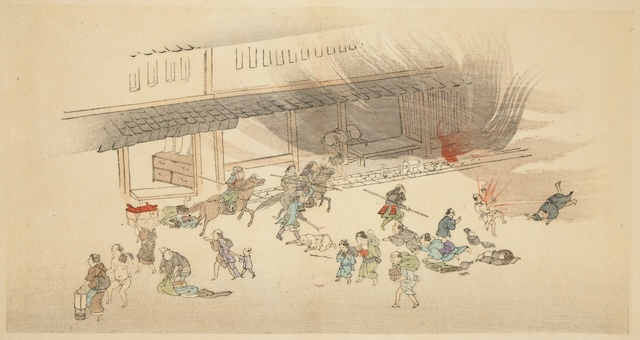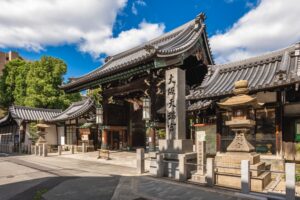Why would a warrior die not to fight—but to protect peace?
In 1864, at the gates of Kyoto’s Imperial Palace, samurai fell one after another—not in conquest, but in silence and resolve.
The Kinmon Incident is more than a footnote in history—it is a mirror reflecting the true heart of Bushido.

On July 19, 1864, a violent conflict known as the Kinmon Incident broke out near the Hamaguri Gate in Kyoto.
It was part of a turbulent period leading up to the Meiji Restoration, when Japan was undergoing internal strife and political transformation.
In the Edo period, a Hen (変) referred to a serious incident requiring military intervention, beyond the scope of what ordinary police forces could manage. Lesser incidents were called Soudou (騒動), and the distinction was strictly observed.
However, the Kinmon Incident was not merely a military clash. It revealed something deeper—an expression of Japan’s unique cultural foundation, shaped by centuries of ethical order and social spirit.
◆ The Samurai Who Preserved the Peace
What is especially noteworthy is that this was the first armed conflict in the Kansai region since the Summer Siege of Osaka in 1615—a span of 249 years.
Such a long era of peace illustrates how Japanese samurai worked to maintain public order while avoiding warfare.
Emerging from the Warring States period, the ideal of “governing without drawing the sword” had taken deep root in the ethos of the samurai.
◆ The Highest Honor: Guarding the Imperial Residence
The term Kinmon refers to the gates surrounding the Kyoto Imperial Palace, the residence of the Emperor.
During the Edo period, these gates were guarded by samurai from various domains on a rotating basis. Remarkably, all costs—travel, lodging, provisions—were borne entirely by the domains themselves; no financial support was provided by the shogunate or the imperial court.
And yet, to be entrusted with guarding the Imperial Palace was considered one of the highest honors for any domain or warrior.
This custom dates back over two thousand years, to a time long before the samurai class existed, when ordinary citizens voluntarily cleaned and protected the palace grounds.
Why was this duty held in such high esteem?
Because the Emperor regarded the people as Oh-Mitakara—the “Great Treasures.”
Rooted in the ancient political philosophy of shirasu kuni—a “Shirasu” nation, governed not by domination, but through virtue and trust—the Emperor stood above power holders, and the people were seen as the most precious asset of the state.
It was a deeply held belief that authority existed solely to serve and protect the people.
Thus, protecting the Emperor’s residence was not merely a military assignment; it was a sacred duty to uphold the very foundation of society itself. For the samurai, it represented the ultimate form of service.
◆ The Art of Standing Still—and the Bullets That Violated It
During the Kinmon Incident, it was the samurai from Aizu and Kuwana han (feudal domains), loyal retainers of the Tokugawa regime, who stood guard at the Hamaguri Gate.
The attacking forces were from the Choshu domain, which had previously held the same honor but had lost it due to political defeat—a humiliation they bore with deep resentment.
Thus, the confrontation became a tragic clash of “honor versus honor,” where the pride of warriors turned to sorrow through violence.
Even as arrows flew and bullets whizzed past, the samurai stationed at the gates stood firm.
That was their sworn duty—and an unbroken tradition inherited from their ancestors.
When one fell, the next took his place. Then another.
To modern eyes, it may appear senseless. But to them, this was Bushido—a commitment to duty, a vow to keep one’s word, and the dignity to maintain one’s stance even unto death.
This is not a glorification of war.
Rather, it raises a profound question: Why did the Japanese go to such lengths to preserve order and peace?
The answer lies at the very heart of Bushido.
◆ Bushido: The Path of Quiet Resolve
Bushido is not about brandishing swords.
Its true essence lies in protecting one’s honor, upholding the dignity of one’s companions, and defending the people—the Great Treasures of the Emperor.
Even in unjust or irrational circumstances, the samurai fulfilled their responsibilities with quiet determination and unwavering discipline.
That was the path of Bushido as lived by the Japanese.
To study history is not merely to recite events.
It is to perceive the soul behind those events—and to ask oneself, “How should I live?”
The Kinmon Incident remains a powerful testament to the pride of the samurai and their unwavering commitment to peace.
Bushido reminds us that the vow to seek peace requires not only hope—but the courage to stand with quiet resolve.


